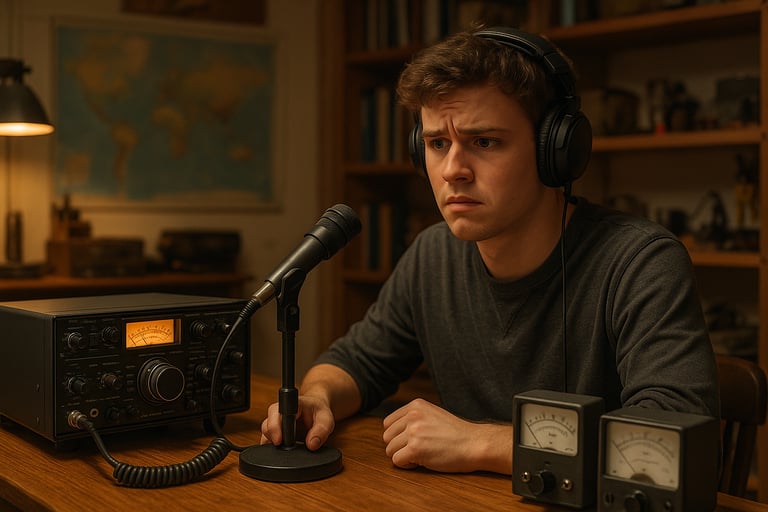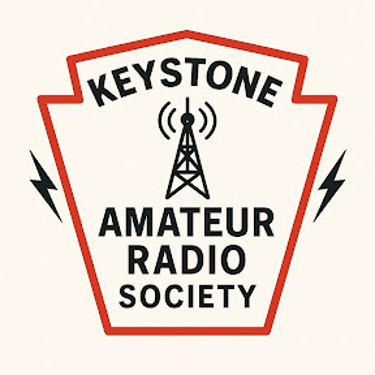Getting Started
Do I need a license first?
Nope! You can come to meetings, listen in, and even join demos before you’re licensed. All are welcome.
I don’t have any gear can I still join?
What is amateur radio?
What if I know nothing about radio?
Perfect. We’ll meet you where you are and help you get on the air with confidence.
Absolutely. No gear, No Problem, we need you and your questions.
Amateur radio is a fun activity that mixes a love for technology, radios, being part of a community, and helping people. It is a popular hobby and public service involving radio communication using designated frequencies and equipment. People use radio signals to talk with others around the world and with many chances to learn from people of all ages and backgrounds.



How to Get Your GMRS & Amateur License
Getting your radio license may sound tricky, but it’s really just a few simple steps. This guide walks you through everything, from studying to getting your license from the FCC.
GMRS (General Mobile Radio Service)
Purpose: Short-to-medium range family or group communication.
Who Can Use It: One license covers the whole family.
Requirements: Must be 18+, no test required.
Cost: $35 for 10 years.
Equipment: Handhelds and mobile radios, usually pre-programmed (limited to GMRS frequencies).
Scope: Mostly local (a few miles to tens of miles, depending on terrain and repeaters).
Learning Curve: Minimal, easy to get started, no technical exam.
Amateur (Ham) Radio
Purpose: A hobby and service for worldwide communication, experimentation, and emergency response.
Who Can Use It: Only the person licensed (family members need their own).
Requirements: Must pass one or more tests (Technician, General, Extra).
Cost: $15 exam + $35 FCC fee, valid for 10 years.
Equipment: Wide range from handhelds to HF base stations, antennas, satellites, digital modes.
Scope: Local, regional, worldwide, even space.
Learning Curve: Higher, requires study and ongoing learning.
How They’re Similar
FCC Regulated: Both licenses are issued by the FCC and tracked in the FCC database.
FRN Required: Both require you to get an FCC Registration Number (FRN) first.
10-Year Validity: Both last 10 years before renewal.
Call Signs: Both come with an FCC-issued call sign.
Community Use: Both promote safe, responsible radio communication.
Cost: Both currently cost $35 through the FCC.
How GMRS Can Lead Into Amateur Radio
Many people start with GMRS because:
It’s simple to get (no test).
It gives instant communication for family, camping, off-roading, or prepping.
It builds confidence using radios and repeaters.
Once comfortable with GMRS, many operators want more range, more freedom, and more learning opportunities, that’s when Amateur Radio comes in.
GMRS repeaters spark curiosity about how repeaters, antennas, and propagation work.
Limited range on GMRS motivates trying HF (shortwave) bands in ham radio.
Being part of a GMRS community often overlaps with local ham clubs, making the jump natural.
Families may keep GMRS for simple group use, while individuals get ham licenses for personal exploration and emergency response.
In short:GMRS = entry-level, simple, family-oriented.
Amateur Radio = broader, technical, worldwide hobby and service.
Many hams start with GMRS, then “level up” to ham radio when they want more range, more challenge, and more fun.
GMRS License
What is GMRS?
GMRS = General Mobile Radio Service. It uses handheld or mobile radios, kind of like walkie-talkies but more powerful. Perfect for families, campers, farmers, and off-roaders.
GMRS Rules
Must be 18 or older
No test required
One license covers your whole family
License lasts 10 years
Cost is $35
How to Get a GMRS License
Study is optional (but good to learn basics).
Get your FRN (if you don’t already have one).
Log in to the FCC ULS with your FRN.
Apply for a ZA – General Mobile Radio Service license.
Pay the $35 fee.
Your license and call sign appear almost instantly!🎙 Amateur (Ham) Radio License
What is Amateur Radio?
Ham radio (also called Amateur Radio) is a hobby where people use radios to talk across town, across the country, and even around the world.
With ham radio you can:
Talk to other people nearby or far away
Learn about electronics, antennas, and space
Help in emergencies when phones or internet don’t work
Even contact astronauts on the ISS!
The FCC (Federal Communications Commission) gives out licenses. The ARRL (American Radio Relay League) is a big national group that helps people learn and get started.
Ham License Levels
There are 3 main license levels in the U.S.:
Technician Class (Beginner)
35 multiple-choice questions
Lets you use local repeaters, handheld radios, and some HF bands
General Class (Intermediate)
Must pass Technician first
Another 35 questions
Lets you talk around the world on more HF bands
Amateur Extra (Advanced)
Final step
50 questions
Gives you full access to all amateur bands
Step 1: Study for the Exam
Use the ARRL License Manual to learn the basics
Take practice tests on HamStudy.org
Download free apps for quick quizzes
Many local clubs hold beginner classes
All real exam questions are public, so practice tests are very helpful.
Step 2: Get Your FCC FRN (Registration Number)
Before you can take your test or apply for GMRS, you need an FRN. This is your FCC account number.
How to Get an FRN:
Go to the FCC CORES Login.
Click Register.
Enter your name, address, and email.
Save your FRN—you’ll use it to take your ham test and to log in later.
Step 3: Take the Exam
Find a test session on the ARRL website or HamStudy.org.
Pay the exam fee (about $15).
Take the test with Volunteer Examiners (VEs).
If you pass, the exam team submits your results to the FCC.
The FCC emails you to pay the $35 fee.
Step 4: Get Your License
After you pay, your license shows up in the FCC database (1–2 days).
You’ll be given a call sign (like WX3S or K1ABC).
You can download/print your license from the FCC’s ULS License Manager.
Quick Checklist
For Amateur Radio:
Study with ARRL books or online tools
Get your FRN
Take the test (Technician first)
Pay $35 to FCC
Get your license & call sign
For GMRS:
Get your FRN
Log in to FCC ULS
Apply for GMRS license
Pay $35
License covers your family
Final Word
Ham Radio: Best for learning, making worldwide contacts, and joining clubs.
GMRS: Best for simple family communication without a test.
Many people get both for the most flexibility.
